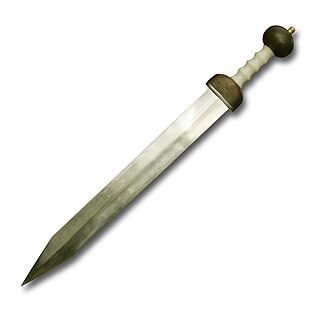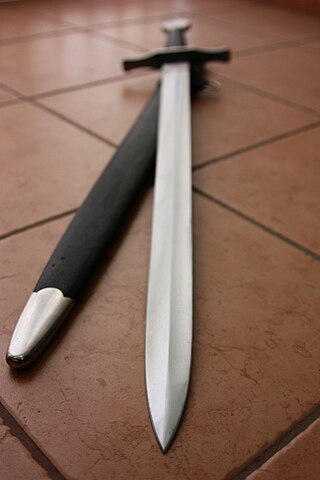
Damascus steel is the forged steel of the blades of swords smithed in the Near East from ingots of carbon steel imported from Southern India or made in production centres in Sri Lanka or Khorasan, Iran. These swords are characterized by distinctive patterns of banding and mottling reminiscent of flowing water, sometimes in a "ladder" or "rose" pattern. Such blades were reputed to be tough, resistant to shattering, and capable of being honed to a sharp, resilient edge.

A forge is a type of hearth used for heating metals, or the workplace (smithy) where such a hearth is located. The forge is used by the smith to heat a piece of metal to a temperature at which it becomes easier to shape by forging, or to the point at which work hardening no longer occurs. The metal is transported to and from the forge using tongs, which are also used to hold the workpiece on the smithy's anvil while the smith works it with a hammer. Sometimes, such as when hardening steel or cooling the work so that it may be handled with bare hands, the workpiece is transported to the slack tub, which rapidly cools the workpiece in a large body of water. However, depending on the metal type, it may require an oil quench or a salt brine instead; many metals require more than plain water hardening. The slack tub also provides water to control the fire in the forge.

Pattern welding is the practice in sword and knife making of forming a blade of several metal pieces of differing composition that are forge-welded together and twisted and manipulated to form a pattern. Often mistakenly called Damascus steel, blades forged in this manner often display bands of slightly different patterning along their entire length. These bands can be highlighted for cosmetic purposes by proper polishing or acid etching. Pattern welding was an outgrowth of laminated or piled steel, a similar technique used to combine steels of different carbon contents, providing a desired mix of hardness and toughness. Although modern steelmaking processes negate the need to blend different steels, pattern welded steel is still used by custom knifemakers for the cosmetic effects it produces.

The Second Punic War was the second of three wars fought between Carthage and Rome, the two main powers of the western Mediterranean in the 3rd century BC. For 17 years the two states struggled for supremacy, primarily in Italy and Iberia, but also on the islands of Sicily and Sardinia and, towards the end of the war, in North Africa. After immense materiel and human losses on both sides, the Carthaginians were once again defeated. Macedonia, Syracuse and several Numidian kingdoms were drawn into the fighting, and Iberian and Gallic forces fought on both sides. There were three main military theatres during the war: Italy, where Hannibal defeated the Roman legions repeatedly, with occasional subsidiary campaigns in Sicily, Sardinia and Greece; Iberia, where Hasdrubal, a younger brother of Hannibal, defended the Carthaginian colonial cities with mixed success before moving into Italy; and Africa, where Rome finally won the war.

Gladius is a Latin word properly referring to the type of sword that was used by ancient Roman foot soldiers starting from the 3rd century BC and until the 3rd century AD. Linguistically, within Latin, the word also came to mean "sword", regardless of the type used.

A blacksmith is a metalsmith who creates objects primarily from wrought iron or steel, but sometimes from other metals, by forging the metal, using tools to hammer, bend, and cut. Blacksmiths produce objects such as gates, grilles, railings, light fixtures, furniture, sculpture, tools, agricultural implements, decorative and religious items, cooking utensils, and weapons. There was an historical distinction between the heavy work of the blacksmith and the more delicate operation of a whitesmith, who usually worked in gold, silver, pewter, or the finishing steps of fine steel. The place where a blacksmith works is called variously a smithy, a forge or a blacksmith's shop.

An anvil is a metalworking tool consisting of a large block of metal, with a flattened top surface, upon which another object is struck.

A blade is the sharp, cutting portion of a tool, weapon, or machine, specifically designed to puncture, chop, slice, or scrape surfaces or materials. Blades are typically made from materials that are harder than those they are intended to cut. This includes early examples made from flaked stones like flint or obsidian, evolving through the ages into metal forms like copper, bronze, and iron, and culminating in modern versions made from steel or ceramics. Serving as one of humanity's oldest tools, blades continue to have wide-ranging applications, including in combat, cooking, and various other everyday and specialized tasks.

Wootz steel, also known as Seric steel, is a crucible steel characterized by a pattern of bands and high carbon content. These bands are formed by sheets of microscopic carbides within a tempered martensite or pearlite matrix in higher-carbon steel, or by ferrite and pearlite banding in lower-carbon steels. It was a pioneering steel alloy developed in southern India in the mid-1st millennium BC and exported globally.
Forge welding (FOW), also called fire welding, is a solid-state welding process that joins two pieces of metal by heating them to a high temperature and then hammering them together. It may also consist of heating and forcing the metals together with presses or other means, creating enough pressure to cause plastic deformation at the weld surfaces. The process, although challenging, has been a method of joining metals used since ancient times and is a staple of traditional blacksmithing. Forge welding is versatile, being able to join a host of similar and dissimilar metals. With the invention of electrical welding and gas welding methods during the Industrial Revolution, manual forge-welding has been largely replaced, although automated forge-welding is a common manufacturing process.
The falcata is a type of sword typical of pre-Roman Iberia. The falcata was used to great effect for warfare in the ancient Iberian peninsula, and is firmly associated with the southern Iberian tribes, among other ancient peoples of Hispania. It was highly prized by the ancient general Hannibal, who equipped Carthaginian troops with it during the Second Punic War.
Sword making, historically, has been the work of specialized smiths or metalworkers called bladesmiths or swordsmiths. Swords have been made of different materials over the centuries, with a variety of tools and techniques. While there are many criteria for evaluating a sword, generally the four key criteria are hardness, strength, flexibility and balance. Early swords were made of copper, which bends easily. Bronze swords were stronger; by varying the amount of tin in the alloy, a smith could make various parts of the sword harder or tougher to suit the demands of combat service. The Roman gladius was an early example of swords forged from blooms of steel.

A metalsmith or simply smith is a craftsperson fashioning useful items out of various metals. Smithing is one of the oldest metalworking occupations. Shaping metal with a hammer (forging) is the archetypical component of smithing. Often the hammering is done while the metal is hot, having been heated in a forge. Smithing can also involve the other aspects of metalworking, such as refining metals from their ores, casting it into shapes (founding), and filing to shape and size.

Knife making is the process of manufacturing a knife by any one or a combination of processes: stock removal, forging to shape, welded lamination or investment cast. Typical metals used come from the carbon steel, tool, or stainless steel families. Primitive knives have been made from bronze, copper, brass, iron, obsidian, and flint.

Bladesmithing is the art of making knives, swords, daggers and other blades using a forge, hammer, anvil, and other smithing tools. Bladesmiths employ a variety of metalworking techniques similar to those used by blacksmiths, as well as woodworking for knife and sword handles, and often leatherworking for sheaths. Bladesmithing is an art that is thousands of years old and found in cultures as diverse as China, Japan, India, Germany, Korea, the Middle East, Spain and the British Isles. As with any art shrouded in history, there are myths and misconceptions about the process. While traditionally bladesmithing referred to the manufacture of any blade by any means, the majority of contemporary craftsmen referred to as bladesmiths are those who primarily manufacture blades by means of using a forge to shape the blade as opposed to knifemakers who form blades by use of the stock removal method, although there is some overlap between both crafts.

Hanwei is a Chinese company manufacturing replica swords and other types of medieval arms and armor. The company was founded in 1990 by Chen Chao-Po.

Japanese swordsmithing is the labour-intensive bladesmithing process developed in Japan beginning in the sixth century for forging traditionally made bladed weapons (nihonto) including katana, wakizashi, tantō, yari, naginata, nagamaki, tachi, nodachi, ōdachi, kodachi, and ya (arrow).
Honyaki (本焼) is the name for the Japanese traditional method of metalwork construction most often seen in kitchen knives by forging a blade, with a technique most similar to the tradition of nihonto, from a single piece of high-carbon steel covered with clay to yield upon quench a soft, resilient spine, a hamon, and a hard, sharp edge. Honyaki as a term alone can refer to either mizu honyaki (water-quench) or abura honyaki. The goal is to produce a sharper, longer lasting edge than is usually achievable with the lamination method. The term has been adapted to describe high-end mono-stainless in Japan and carbon blades by non-Japanese bladesmiths that have a hamon but are made with Western steel, heat treat, equipment, finishing, and design.
A laminated steel blade or piled steel is a knife, sword, or other tool blade made out of layers of differing types of steel, rather than a single homogeneous alloy. The earliest steel blades were laminated out of necessity, due to the early bloomery method of smelting iron, which made production of steel expensive and inconsistent. Laminated steel offered both a way to average out the properties of the steel, as well as a way to restrict high carbon steel to the areas that needed it most. Laminated steel blades are still produced today for specialized applications, where different requirements at different points in the blade are met by use of different alloys, forged together into a single blade.

The Caetrati were a type of light infantry in ancient Iberia who often fought as skirmishers. They were armed with a caetra shield, swords, and javelins.














